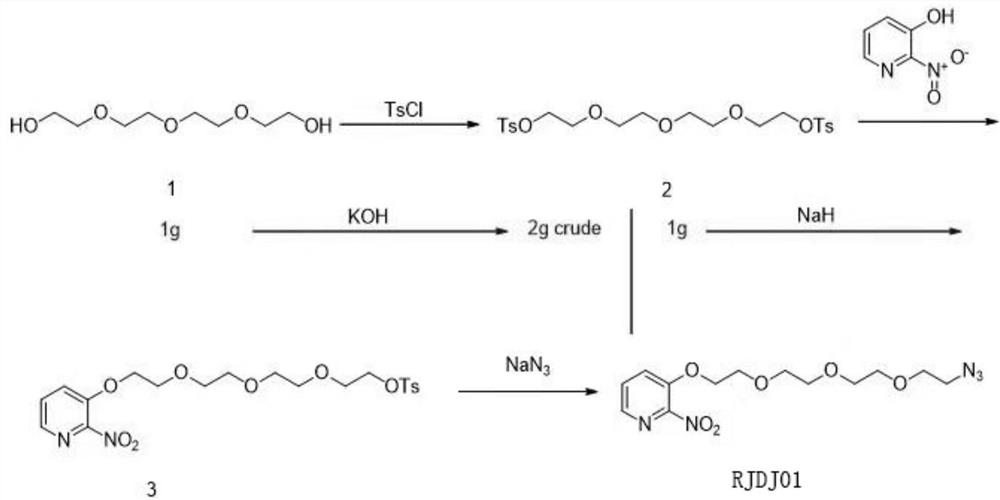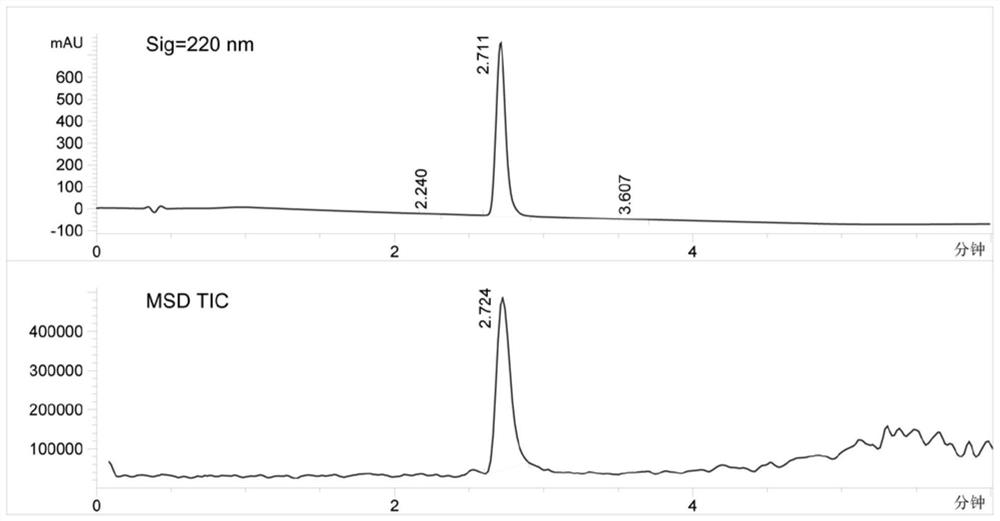18F labelled nano antibody probe, and preparation method and application thereof
A nanobody and 18F technology, applied in the field of nuclear medicine and molecular imaging, can solve the problems of large bone marrow puncture trauma, poor repeatability, false positives, etc., and achieve the effects of wide application range, reduced preparation cost, and accurate detection
- Summary
- Abstract
- Description
- Claims
- Application Information
AI Technical Summary
Problems solved by technology
Method used
Image
Examples
Embodiment 1
[0051] Example 1 Synthesis of RJDJ01
[0052] Such as figure 1 The synthetic route shown autonomously synthesizes RJDJ01:
[0053] 1. Accurately weigh 1g of tetraethylene glycol (about 5.1mmol), dissolve it in 15mL of dichloromethane, then mix 2g (about 10.5mmol) of p-toluenesulfonyl chloride and 0.59g of potassium hydroxide (about 10.5 mmol) was slowly added to the above mixture and reacted overnight at room temperature. After washing with water, the liquid was separated to obtain 2 g of crude product (yield about 78%).
[0054] 2. The above crude product was dissolved in dichloromethane, then 0.56g (about 4mmol) of 3-hydroxyl-2-nitropyridine and 96mg of sodium chloride (about 4mmol) were added, and after overnight reaction at room temperature, column chromatography separated to obtain 1g (about 2.1 mmol) of 2-(2-(2-(2-((2-nitropyridin-3-yl)oxy)ethoxy)ethoxy)ethoxy)4-methylbenzenesulfonate Acetate ethyl ester, the yield is about 51%.
[0055] 3.940 mg (about 2 mmol) of 2...
Embodiment 2
[0057] Embodiment 2 Click chemical reaction substrate 1 18 Automated preparation of F[F]-RJDJ01
[0058] The specific experimental scheme is as follows: Weigh 2–2.5 mg RJDJ01, dissolve it in 1 mL dimethyl sulfoxide (DMSO); transfer 18F-fluoride (33.49–39.39 GBq) with a pre-balanced anion exchange Potassium carbonate (3mg) and 4,7,13,16,21,24-hexaoxa-1,10-diazabicyclo[8.8.8]hexacosane (15mg) were used as the mobile phase to wash the anion exchange column; after the solvent was evaporated to dryness, add RJDJ01 dissolved in 1mL DMSO; the reaction system was heated at 120°C for 14 minutes; 3mL sterilized water for injection was added to the reaction system, the reaction system was transferred to a C18 column, and the mobile phase was set to 0.1% trifluoroacetic acid containing 32% acetonitrile ( trifluoroacetic acid), set the flow rate to 4.6mL / min, purified by HPLC, collected 18 F-RJDJ01 to the pear-shaped bottle; add 10mL sterile water for injection to the pear-shaped bottle ...
Embodiment 3
[0059] Example 3 Preparation of click chemical reaction substrate DBCO-MM01, and preparation of novel CD38-specific nanobody probes by click chemical reaction 18 F[F]-MM01
[0060] The reaction principle is as Figure 5 18 As shown in the schematic diagram of F randomly labeled nanobody, the click chemical reaction substrate DBCO-MM01 was prepared, and the novel CD38-specific nanobody probe was prepared through the click chemical reaction 18 F[F]-MM01.
[0061] DBCO-NHS ester (CAS#:1353016-71-3, MeloPEG) was randomly coupled with MM01 to prepare the click chemistry reaction substrate DBCO-MM01. The specific steps are as follows: Dissolve 1 mg of CD38-specific nanobody MM01 in phosphate buffered saline (PBS) with a volume of about 1 mL, add 80–100 μL of 0.1M sodium carbonate (Na2CO3) buffer to adjust the pH of the nanobody solution to 9.0–10. DBCO-NHS ester freshly dissolved in dimethyl sulfoxide (DMSO) was added to the Nanobody solution at a DBCO-NHS ester / MM01 molar ratio...
PUM
| Property | Measurement | Unit |
|---|---|---|
| emissivity | aaaaa | aaaaa |
Abstract
Description
Claims
Application Information
 Login to View More
Login to View More - R&D Engineer
- R&D Manager
- IP Professional
- Industry Leading Data Capabilities
- Powerful AI technology
- Patent DNA Extraction
Browse by: Latest US Patents, China's latest patents, Technical Efficacy Thesaurus, Application Domain, Technology Topic, Popular Technical Reports.
© 2024 PatSnap. All rights reserved.Legal|Privacy policy|Modern Slavery Act Transparency Statement|Sitemap|About US| Contact US: help@patsnap.com










